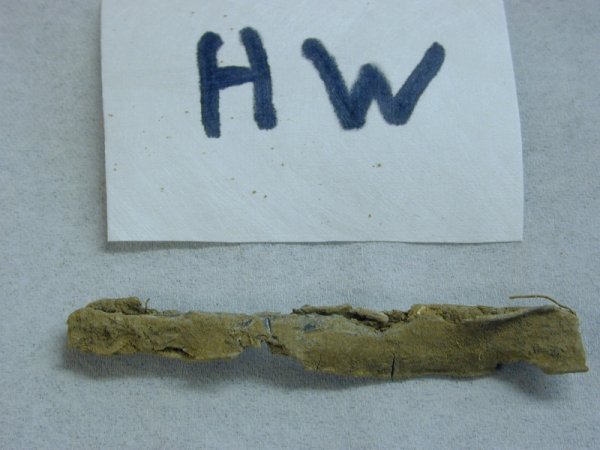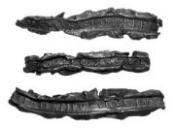Lead Window

Conservator’s Notes
Turned window leads are commonly found on colonial sites. Due to the softness of the lead , a window came is rarely found completely intact. They are commonly found smashed, twisted, bent and misshapen with the sides bent inwards. Leads are commonly cleaned in the conservation laboratory to remove obscuring lead-oxide and lead-carbonate corrosion products. Unlike harder metals such as iron and coppers, lead cannot be cleaned mechanically because it can easily be scratched or damaged during this process. Instead, lead is one of the only metals that is still best cleaned by immersing the artifact in a mild acid solution. Slowly, bit by bit, the corrosion is removed from the surface of the lead without damaging the soft metal. This process is very slow, and must be performed carefully so that only the corrosion products are removed and nothing else is damaged. After cleaning the lead is then rinsed, dried and coated. But before these final steps are taken, a window lead may undergo an additional step in the conservation process.
Window leads are special artifacts, because they are often marked inside with the maker’s mark, initials, emblems and/or a date. The maker of the window lead commonly “marked” the interior of the lead came with a date and mark using a tool during manufacturing. In order to locate this type of mark on a window lead, the conservator must open the lead which has become smashed together during burial. The edges of the “H” design (see below under Curator’s notes) are carefully and slowly pried apart using very soft wooden tools, allowing for minimal damage. When the two edges of the window came are straightened into the original “H” shape, the lead is then cleaned further to remove any remaining dirt and corrosion. If you are lucky, a maker’s mark and date could be located in this area of the artifact. Not every window came has a mark, some are marked with simple lines from the manufacturing or part of an original mark may be all that remains visible. These marks are very important as they can pinpoint specific dates for the archaeologists and tell us when buildings were constructed, deconstructed and/or moved.
Curator’s Notes
The glass in windows in the 17th century was held together with small “H” shaped lead strips known as turned lead. Often, these bear maker’s marks and dates. The marks are located inside the “H” and cannot be seen in a completed window. They served to identify the maker of failed windows.


